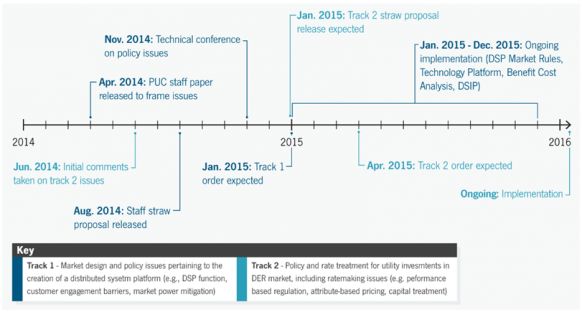Across the country, utilities are beginning to confront the most dramatic transformation of their business in the past century. They face challenges from customer-owned distributed energy resources (DERs), as well as opportunities in the form of smarter distribution grid technology and analytics, both of which lead to new models for electricity delivery and consumption. Regulators will be solely responsible for designing these models, with an emphasis on fostering innovation and improvement while maintaining reliability and containing costs.
For its latest report, Regulating the Utility of the Future: Implications for the Grid Edge, GTM Research analyzed tens of thousands of pages of regulatory dockets across the five states at the forefront of this change: California, Hawaii, Massachusetts, Minnesota and New York. Report author Bentham Paulos writes, "The rules being written today will define the business opportunities of tomorrow."
Each state has its own unique set of challenges and opportunities, but common threads exist between markets. The dockets will answer fundamental questions such as who will own distributed energy resources, how changing rate designs will accommodate or block innovation, how regulators will measure the performance of distribution utilities, and how it will affect their profits.
The report dives into each of the five states and its dockets. Of the states analyzed, New York's Reforming the Energy Vision, or REV, initiative is cited as the "single most-watched docket in the country, with 275 parties intervening and filing comments." Paulos suggests that even companies not in the New York market should keep an eye on the state and its pilot programs as an opportunity to prove the viability of grid-edge solutions.
FIGURE: Timeline of New York Dockets (click to enlarge)
Source: Regulating the Utility of the Future: Implications for the Grid Edge
"The states reviewed in the report," writes Paulos, "are on the leading edge of utility policy, either responding to growing pressure for change or seeking the benefits that grid-edge technologies and services can offer."
"The grid edge transformation is entirely reliant on smart utility regulation,” said Shayle Kann, Senior Vice President of GTM Research. “This report sheds light on the states where regulators are deliberately steering a course toward the utility of the future."
Most of the proceedings discussed in the report are still underway, so opportunities to affect their outcomes remain. The report can serve as a field guide for grid-edge companies seeking to track the many proceedings that will ultimately determine their future business opportunities.
Dockets and proceedings analyzed include:
- California AB 327 Distribution Resource plans and “NEM successor” proceedings
- California Energy Storage Procurement
- Hawaii dockets on distributed energy, power supply, and revenue models
- Massachusetts dockets on grid modernization, rate design, and electric vehicles
- New York’s REV docket and grid edge pilot projects
- Minnesota dockets on solar power, data privacy, and smart grid, and the e21 project
- A number of other pertinent efforts and initiatives across the U.S.
For more information on GTM Research’s new Regulating the Utility of the Future report, visit http://www.greentechmedia.com/research/report/regulating-the-utility-of-the-future.
***
To gain access to all of GTM Research's grid reports and a host of other benefits, join the Grid Edge Executive Council.




